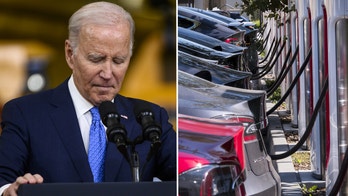
** FILE ** A mother polar bear and her cub sleep near the ice outside Churchill, Canada Nov. 4, 2006. Computer predictions of a dramatic decline of sea ice in regions of the Arctic are confirmed by actual observations, according to scientists for the National Oceanic and Atmospheric Administration and could have profound effects on marine mammals dependent on the sea ice such as polar bears, now under consideration by the U.S. Fish and Wildlife Service for "threatened" status under the Endangered Species Act. (AP Photo/CP/Jonathon Hayward, File) (AP)
Americans should work less, play more -- and in doing so, save the planet. That’s the basic formula a Washington think tank is shopping around as a way to cut down on global warming.
The shift from a U.S. work model to a more "European" one – which includes shorter work weeks and more vacation time -- could cut as much as half of the expected global temperature rise by 2100, according to a new report from the Center for Economic and Policy Research. The study claims that scaling back on work hours could bring down greenhouse gases.
“The calculation is simple: fewer work hours means less carbon emission, which means less global warming,” economist David Rosnick said.
Assuming that 40-to-60 percent of potential global warming is already locked in, about one-quarter to one-half of the warming that is not already locked in could be cut by scaling back hours, Rosnick, who wrote the study, said.
“For many years, European countries have been reducing work hours -- including by taking more holidays, vacation and leave – while the United States has gone the route of increased production, but it might be time for a change,” Rosnick told FoxNews.com Tuesday.
But it's not all umbrella-drinks and beaches. There is a trade-off that many people may not like, he said.
“Obviously, if you are working less, you’re buying less,” he said. “That’s the flip side.”
Rosnick’s study released this week is similar to a 2006 one he co-wrote with economist Mark Weisbrot that looked at the potential environmental effects of European and other countries adopting the American ethic of longer work hours.
In that report, the authors found that “Old Europe” currently consumes about half as much energy per person as does the U.S. If Europe upped its production levels, they would most likely consume 30 percent more energy. The report outlined how worldwide energy patterns could be dependent on which model developing countries choose to copy in the coming years. If they choose to follow the U.S. model, they would apparently consume 30 percent more energy than they do now.




